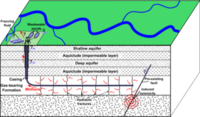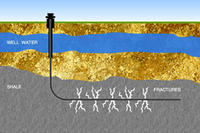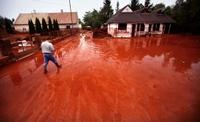-
California’s hydropower is vulnerable to climate change
Fifteen percent of California’s electricity comes from hydropower, a cheap and relatively clean energy source; .about 75 percent of this hydropower comes from high-elevation units, located above 1,000 ft.; with most of them located in Northern California and the Sierra Mountains; if California loses snowpack under climate warming, these high-elevation reservoirs might not be able to store enough water for hydropower generation in summer months when the demand is much higher
-
-
Dropping lake levels in Michigan are a cause for concern
In a state that boasts 11,000 lakes, Michigan is going through a year long drought that has residents and businesses scrambling as water levels continue to decrease; the low waters is the result of low snowpack last winter and a hot dry summer this year
-
-
Improved disaster resilience is imperative for U.S: report
A new report from the National Academies says that it is essential for the United States to bolster resilience to natural and human-caused disasters, and that this will require complementary federal policies and locally driven actions that center on a national vision – a culture of resilience; improving resilience should be seen as a long-term process, but it can be coordinated around measurable short-term goals that will allow communities better to prepare and plan for, withstand, recover from, and adapt to adverse events
-
-
Extreme summer heat events, global warming linked: research

Since the late 1980s researches have been asserting that global warming would reach a point in the coming decades when its connection to extreme events would become more apparent; while some warming should coincide with a noticeable boost in extreme events, the natural variability in climate and weather can be so large as to disguise the trend; to distinguish the trend from natural variability, NASA researchers turned to statistics; the researchers did not focus on the causes of temperature change, analyzing instead surface temperature data
-
-
Study finds correlation between injection wells and small earthquakes

Most earthquakes in the Barnett Shale region of North Texas occur within a few miles of one or more injection wells used to dispose of wastes associated with petroleum production such as hydraulic fracturing fluids, according to new research
-
-
Study finds substantial water pollution risks from fracking

The Marcellus Shale region covers approximately 124,000 square kilometers from New York to West Virginia and is being intensely developed; a new study finds that the disposal of contaminated wastewater from hydraulic fracturing — commonly known as fracking — wells producing natural gas in the Marcellus Shale region poses substantial potential risks of river and other water pollution
-
-
Obama’s sweeping immigration initiative goes into effect next week

On 15 August 2012 a sweeping new immigration initiative, the most significant easing of immigration policy since President Ronald Reagan granted amnesty to an estimated three million people in 1986, goes into effect; it would defer deportation action against, and grant a work permit to, illegal immigrants who meet certain criteria
-
-
Critics charge Obama initiative is amnesty by executive order
Critics of the Obama administration’s immigration order charge that the administration is”legislating by executive edict”; they say that the Obama administration is set, in effect, to begin implementing the DREAM Act amnesty on 15 August, even though the legislation was defeated by Congress as recently as December 2010
-
-
New forensic tool automates RAM forensic investigations
New tool enables computer forensic investigators to analyze and make use of information contained in volatile memory; memory analysis produces important, case-relevant data for investigators that cannot be obtained from disk analysis, such as running applications, open files, and active network connections
-
-
DHS develops active shooter national guidance
DHS has selected a training program from the Center for Personal Protection and Safety (CPPS) as resource in developing national guidance for how to respond to an active shooter situation
-
-
The homeland security market 2012-22
New market research reports estimates that the value of the homeland security market in 2012 amounts to $206.01 billion; the continually evolving nature of many homeland security threats entails continued scope for enterprise, particularly in areas where new technology can be applied to security problems
-
-
Canadian company offers the first treatment to neutralize red mud

Red mud is the most significant waste product of the traditional Bayer process for aluminum production; the industry produces more than 100 million tons of red mud a year, of which less than 5 percent is be reused; the rest is stored in ponds and reservoirs, posing serious environmental and economic risk; on 4 October 2010, for example, a flood of toxic red mud devastated Hungary after a retaining dyke ruptured, causing an ecological disaster; Canadian company Orbite Aluminae offers a technology to tackle the aluminum industry’s most serious problem
-
-
Critics charge DHS chemical plant security program a failure
In 2006 Congress passed the Chemical Facility Anti-Terrorism Standards program, or CFATS, which set security standards chemical plants had to meet; there are 4,400 chemical plants covered by CFATS, of which 120 are considered especially dangerous, as a chemical release– accidental or as a result of a terrorist act — in any one of them would cause hundreds of thousands of casualties; after four-and-half years and $480 millions spent on CFATS, not a single plant of the 4,400 had been fully inspected; of the 120 riskiest plants, 11 had a preliminary inspection done; not a single site security plan has been approved
-
-
Improving landmine detection – and air travel safety

It is estimated that there are about 110 million active landmines lurking underground in sixty-four countries across the globe; each year as many as 25,000 people, most of them civilians, are maimed or killed by landmines; the mines not only kill and maim, they can paralyze communities by limiting the use of land for farming and roads for trade; researchers offer a better way to detect landmines – a method which can also be used in airports to help thwart possible terrorist threats
-
-
Improving oil recovery, aiding environmental cleanup
Researchers have taken a new look at an old, but seldom-used technique developed by the petroleum industry to recover oil, and learned more about why it works, how it could be improved, and how it might be able to make a comeback not only in oil recovery but also environmental cleanup
-
More headlines
The long view
Ransomware Attacks: Death Threats, Endangered Patients and Millions of Dollars in Damages
A ransomware attack on Change Healthcare, a company that processes 15 billion health care transactions annually and deals with 1 in 3 patient records in the United States, is continuing to cause massive disruptions nearly three weeks later. The incident, which started on February 21, has been called the “most significant cyberattack on the U.S. health care system” by the American Hospital Association. It is just the latest example of an increasing trend.
Chinese Government Hackers Targeted Critics of China, U.S. Businesses and Politicians
An indictment was unsealed Monday charging seven nationals of the People’s Republic of China (PRC) with conspiracy to commit computer intrusions and conspiracy to commit wire fraud for their involvement in a PRC-based hacking group that spent approximately 14 years targeting U.S. and foreign critics, businesses, and political officials in furtherance of the PRC’s economic espionage and foreign intelligence objectives.
European Arms Imports Nearly Double, U.S. and French Exports Rise, and Russian Exports Fall Sharply
States in Europe almost doubled their imports of major arms (+94 per cent) between 2014–18 and 2019–23. The United States increased its arms exports by 17 per cent between 2014–18 and 2019–23, while Russia’s arms exports halved. Russia was for the first time the third largest arms exporter, falling just behind France.
LNG Exports Have Had No Impact on Domestic Energy Costs: Analysis
U.S. liquified natural gas (LNG) exports have not had any sustained and significant direct impact on U.S. natural gas prices and have, in fact, spurred production and productivity gains, which contribute to downward pressure on domestic prices.
